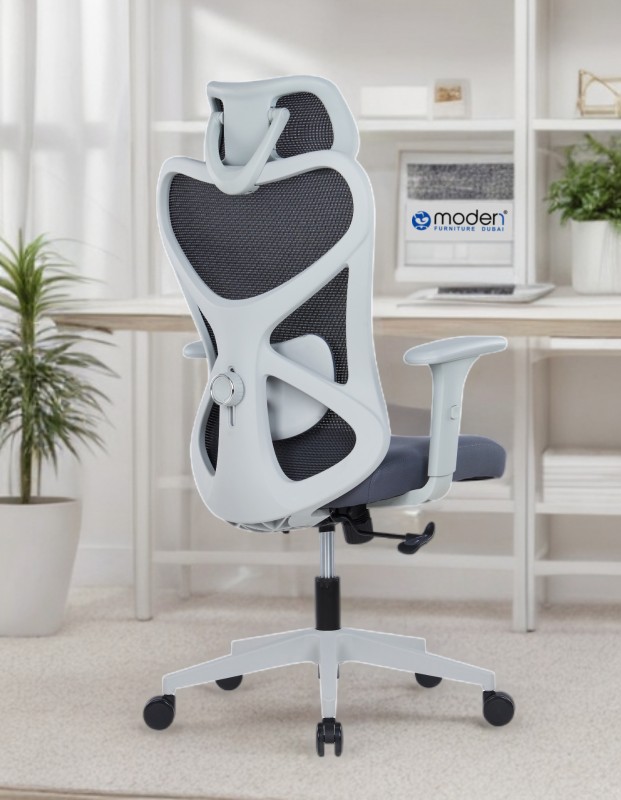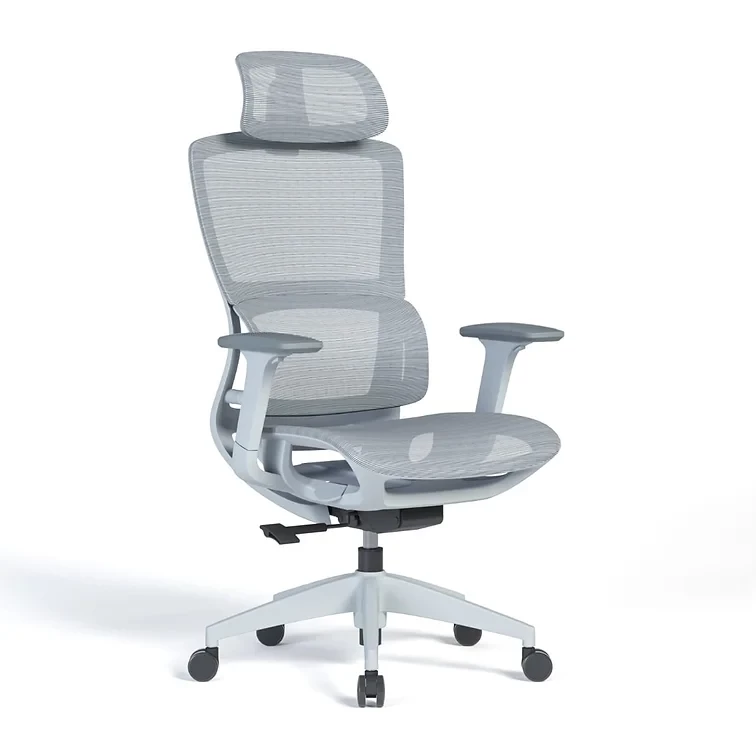
How Adjustable Arms Improve Office Chair Ergonomics
introsuction
Office ergonomics isn’t just about the seat or backrest—it’s also about the subtle support systems that align the body naturally during work. Among these, adjustable armrests play a surprisingly critical role. Often overlooked, they help relieve pressure on the shoulders, support better posture, and reduce fatigue during long hours at a desk. Whether you’re a designer, manager, or remote professional, armrest adjustability can be the key to unlocking a healthier, more productive workday.
1. Reducing Shoulder and Neck Strain
One of the biggest benefits of adjustable arms is their ability to alleviate shoulder tension. Without arm support, your shoulders tend to rise, leading to neck strain over time. Properly adjusted armrests let your arms rest naturally, relaxing your upper body and reducing muscle fatigue.
2. Promoting Proper Elbow Angles
Ergonomists recommend maintaining a 90 to 110-degree angle at the elbows while working. Adjustable arms help you achieve this consistently by rising or lowering to meet your forearms. When elbows fall too low or sit too high, it causes strain and poor typing posture. Adjustable arms correct this easily.
3. Enhancing Postural Stability
When your arms are properly supported, your spinal alignment improves. Without the need to tense or lean forward, your body naturally maintains a more upright, centered position. This stability leads to less slouching and fewer instances of lower back discomfort.
4. Reducing Pressure on the Wrists
With adjustable arms set at the correct height, your wrists and forearms remain aligned, especially during typing or mouse work. This reduces stress on the carpal tunnel area and can help prevent repetitive stress injuries like tendonitis or carpal tunnel syndrome.
5. Customizing Support for Various Tasks
Modern workdays involve more than typing. Whether you’re reading, writing, presenting, or on calls, adjustable arms can be raised, lowered, widened, or angled to suit different activities. This customization ensures consistent ergonomic support across your work routine.
6. Accommodating Different Body Types
Everyone’s body is different, and one-size-fits-all armrests don’t suit all users. Adjustable arms allow people of different heights and builds to personalize their setup. This makes shared workspaces more inclusive and promotes overall comfort.
7. Supporting Natural Movement
Adjustable arms promote micro-movements by allowing dynamic posture changes throughout the day. When your arms can rest in different positions, your body moves more naturally—an important factor in long-term musculoskeletal health.
8. Preventing Chair Misalignment
Without proper armrest height, users may sit too far from the desk or slide forward in their chairs. Adjustable arms allow you to align closer to the desk edge, keeping your posture upright and helping you stay connected to your workstation without slouching.
9. Facilitating Better Desk Compatibility
Desks and chairs aren’t always perfectly matched. Adjustable arms make it easier to fit your chair under different table heights or move in and out of various workstation setups. This adaptability is especially useful in hybrid or multi-use work environments.
10. Increasing Overall Comfort and Endurance
When armrests are set correctly, they distribute upper-body weight, reducing pressure on the spine and hips. Over long periods, this contributes to greater comfort and endurance, allowing you to focus on work rather than bodily discomfort.
Additional Considerations When Choosing Chairs with Adjustable Arms
11. Look for Multi-Dimensional Adjustability
Some chairs offer 2D (height and width) adjustment, while others provide 4D options that include forward/backward movement and pivot angles. The more dimensions available, the more precisely you can tailor the fit to your body.
12. Prioritize Soft, Padded Arm Surfaces
Hard plastic armrests can cause discomfort over time. A quality ergonomic chair includes padded or cushioned armrests that are gentle on the forearms and reduce pressure points during extended use.
13. Ensure Smooth and Silent Adjustments
Premium chairs allow for seamless, quiet adjustments—a detail often overlooked. Smooth levers and stable locking mechanisms enhance usability and prevent distractions in professional settings.
14. Match with Desk Height and Keyboard Tray
Your armrest adjustments should align with your desk surface or keyboard tray to create a neutral posture zone. If they’re too low or too high, you may develop shoulder or wrist strain despite having a good chair.
15. Test Adjustability Range Before Buying
Some chairs have limited adjustment ranges that may not suit taller or shorter individuals. Check product specs or try in person, if possible, to ensure the chair's adjustability accommodates your ergonomic needs.
16. Choose Designs That Support Lateral Movements
Tasks like mousework or reaching across the desk benefit from armrests that pivot or slide side-to-side. This added flexibility improves both comfort and productivity throughout varied workflows.
17. Avoid Overly Wide or Fixed Armrest Designs
Chairs with fixed-width arms can cause discomfort by forcing unnatural arm positions. Adjustable arms allow for natural arm spacing, especially important for people with narrower or broader shoulders.
18. Consider Space for Leg and Hip Movement
Adjustable armrests shouldn’t obstruct hip or thigh rotation. Look for designs that move out of the way when needed or allow easy chair entry and exit—important for dynamic work environments.
19. Evaluate Durability and Build Quality
Frequent adjustment requires strong construction. Armrests made from reinforced materials and quality mechanisms last longer and maintain their precision even after years of use.
20. Factor in Visual Integration with Chair Design
While functionality is key, armrests should also complement the overall look of your chair. Chairs that integrate adjustability discreetly into the design maintain a clean, professional appearance.
Recommended Products
Explore ergonomic chairs that feature well-designed adjustable arms for superior comfort:

-
UComfort Super Ergonomic Executive Office Chair – White
This high-back chair offers premium comfort with fully adjustable arms that support a neutral elbow position. Its ergonomic form and elegant white finish make it ideal for modern office setups focused on both function and aesthetics.
-
Chablo Executive High-Back Ergonomic Office Chair – Grey
Designed for professionals who prioritize posture, the Chablo chair features multi-dimensional armrest adjustment. Its contemporary design and breathable mesh back ensure a stylish, ergonomic solution for long hours at work.
Final Thoughts
Adjustable armrests are one of the most overlooked yet critical components of ergonomic chair design. They reduce strain, improve posture, and allow you to tailor your workstation to your body’s needs. Whether you're working from home or in a corporate environment, investing in a chair with well-designed arm support can drastically improve your physical well-being and productivity.
The right chair doesn’t just support your spine—it aligns your arms, shoulders, and wrists with how you work. With customizable support from high-quality chairs like the UComfort or Chablo, your workspace can finally meet your body where it is.
FAQs
Q1: Are adjustable armrests really necessary in office chairs?
Yes, they help align your arms and shoulders, reducing tension and promoting better posture during extended work sessions.Q2: What is the ideal height for armrests?
Armrests should allow your elbows to bend at about 90–110 degrees while keeping shoulders relaxed and wrists neutral.Q3: Can adjustable arms help prevent carpal tunnel syndrome?
Yes. Proper arm support can keep wrists aligned and reduce the repetitive stress that often contributes to carpal tunnel.Q4: Do adjustable arms make a difference for people of different heights?
Absolutely. They allow users to customize their seating posture regardless of height or build, promoting inclusive ergonomics.


